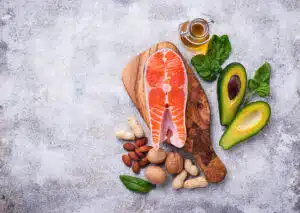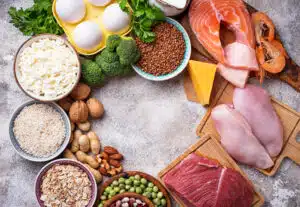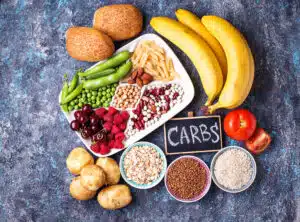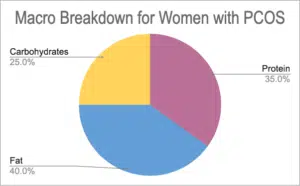There is a debate that rages on – what are the best macros for PCOS? Should we be eating low carb or keto, higher carb but lower fat? Everyone seems to have an opinion on it but before we jump to conclusions, we need to understand what the science says about the best macro breakdown for women with PCOS.
Women with PCOS do well with a macro breakdown of 25% carbs, 35% protein, and 40% fat. This will help us to feel more satiated after meals, provide enough fiber to maintain good gut health and provide us with enough energy for our daily routine.
Of course, what you eat within that macro breakdown is also super important. You could still eat pizzas, pasta, and processed foods and fall within to those macros. That doesn’t mean that it is going to help your PCOS though.
My free “How to Manage PCOS Naturally” training goes into a lot of detail on macros for PCOS, how much of each we should be eating and there is also a really helpful visual download that you get when you attend the training. You can check it out here.
Let’s have a closer look at what macronutrients are and why we need each one for our overall health and our PCOS.
What are macros?
Macros is short for macronutrients. Macronutrients are compounds that we consume that provide us with the energy we need in a day. These compounds include carbohydrates, fats and proteins.
And various diets recommend different macro breakdowns. The one that springs to mind is the low carb or keto diet which suggests that most of our energy intake comes from fats and proteins instead of carbohydrates. And many women with PCOS have great success on a low carb diet.
But, it is also very difficult to stick to and may not be sustainable over the longer term. So, let’s have a quick look at the role of each macronutrient and roughly what a feasible macronutrient breakdown would look like for someone with PCOS.
Carbohydrates
Carbohydrates (or carbs) are often the body’s main source of energy. They are broken down in the body into it’s simplest form – glucose.
The body uses these glucose molecules for energy production and every tissue and organ in the body can use glucose. This is why you can feel very sluggish and tired when you first start of a keto diet – your body has not yet adapted to using fat as a fuel source and glucose levels run low, making you feel tired.
So, carbs are necessary and IN THE RIGHT AMOUNT can help us to feel energized and focused.
And it is important to realize that not all carbs are created equal. Compare a pizza vs a salad with quinoa and other whole grains.
The pizza is going to be quickly processed, provide little fiber or other nutritional benefits and will probably leave you feeling sluggish and bloated. Not to mention that you would have consumed a ton of calories without that much nutritional benefit.
Now, the salad on the other hand. It will have slower releasing carbs with more fiber. Your body will take longer to process those carbs and you won’t need as much insulin to cope with it. Also, you’re getting a whole lot more nutritional bang for your buck.
So, now that we know a little more about the role of carbohydrates in our diets, let’s have a look at what happens when you eat too many carbs.
What happens when you have too much carbohydrate or the wrong types of carbs?
Your body needs insulin to transport glucose from the bloodstream to the muscles and cells of the body. As soon as your body detects higher levels of glucose in the blood, insulin is released. Once the muscle and cells have been restocked, any excess glucose is stored in the body as fat.
Carbs and PCOS
So, what does this have to do with PCOS? We know that women with Polycystic Ovary Syndrome tend to be insulin resistant (DeUgarte, D.A., et al, 2005). This means that we need more insulin than normal to manage excess glucose in the bloodstream.
But the other problem is that our ovaries tend to be particularly sensitive to insulin and they release too much testosterone.
So, if we can manage our insulin levels, we’ll also be able to manage our testosterone levels.
With all of that in mind, you may well think that carbs are the enemy and that a ketogenic diet for PCOS makes the most sense.
Well, not necessarily. The fiber that we get in carbohydrates can help our bodies get rid of excess sex hormones. Also, fiber is important for our gut health and we now know that the gut microbiome plays a really important role in our PCOS.
Eliminating or drastically reducing carbohydrates is not necessarily the right answer for women with PCOS.
Perhaps including the right kinds of carbohydrates in moderate amounts and improving our insulin sensitivity is a more balanced approach?
Fats

Every single cell wall has fats and they play an important role in the formation of our sex hormones. A lot of fat-soluble vitamins also need dietary fat to be adequately absorbed by the body.
A couple of years ago, when the low-fat diet was still the craze, people actually gained more weight than they lost. This is because fats don’t necessarily cause weight gain.
Fats also take a long time to digest and can help us feel fuller for longer. This is one of the main benefits of a keto diet. You tend to feel satiated and actually want to eat less.
Now, it might seem like we’re heading back in the direction of a keto diet for PCOS but that is not necessarily the case.
You see, fats also contain the most calories per gram than either fats or protein. So, a high-fat diet also tends to be high in calories.
And the total calories we consume are still important. In order to lose weight, we need to burn more calories than we eat (calorie restriction). So, having a higher fat diet will make it easy to consume too many calories which will make weight loss more difficult.
Okay, let’s move on and have a look at the last macronutrient.
Protein

Protein is commonly found in animal products but there are also lots of plant-based sources of protein.
You might be wondering how much protein we actually need. Well, Precision Nutrition suggests that we should be aiming for about 1.4g per kg of bodyweight. That means that a 68kg women would need about 95g of protein per day.
If you are doing a lot of strength training then your protein needs will be more than that to assist in the repair and building of muscle tissue.
So, now that we know what each macronutrient is responsible for, let’s look at what the macronutrient breakdown could look like for someone who wants to manage the symptoms of PCOS in a sane and sustainable way.
The Best Macro Breakdown for Women with PCOS
The main aim of the PCOS diet is to better manage the symptoms of PCOS including:
- Balance hormone levels
- Achieve fat loss and lose weight
- Regulate our cycle
- Manage hair growth and hair loss
And while the PCOS diet suggests what we should and shouldn’t be eating, it does not recommend HOW much of each type of food we could be eating.
Now, considering that a lot of us tend to be insulin resistant or have difficulty processing carbohydrates, it would make sense to have fewer carbs than the Standard American Diet. Also, increasing protein intake can help us feel fuller for longer without adding a lot of the extra calories that fats would provide.
So, something like this macro breakdown makes sense for women with PCOS:
What does this look like in real life?
Precision Nutrition suggests the following as a guideline:
- 1 palm of protein dense foods at each meal
- 1 fist of vegetables at each meal
- 0.5 cupped handful of carb dense foods at each meal
- 2 thumbs of fat dense foods at each meal
This is simply a starting point. Your activity levels will determine your calorie needs so don’t see this as a hard and fast rule. Use it as a starting point and adjust as you need to.
Using this breakdown while following the PCOS diet should help to manage the hormonal imbalances so prevalent in women with PCOS and will hopefully result in improvements in your PCOS symptoms.
How to Track Macros
Tracking macro breakdown can be really tedious and it is not always necessary unless you love this kind of stuff.
Using the hand portion guide above is a really good place to start. BUT, if counting macros is your kind of thing, then The PCOS Foodies meal planning app is a really good option for you. It will allow you to meal plan using over 2000 PCOS friendly recipes, as well as track your daily macros.
There is also My Fitness Pal of course!
So, what do you think of this macro breakdown? Have you had success with something different? I’d love to hear from you! Leave me a comment and let me know your thoughts.
- sustainable pcos weight loss strategies
- Over 5500 women have done it and seen results
- [bonus] Done for you pcos meal plans
- [bonus] intermittent fasting for pcos course
- [BONUS] personalised nutrition plan
JOIN OVER 5,500 OTHERS
References
1DeUgarte, C.M; Bartolucci, A.A; Azziz, R. Prevalence of insulin resistance in the polycystic ovary syndrome using the homeostasis model assessment. FERTILITY AND STERILITY, 2005.
2Guo, Y; Yane, Q; Yang, X; et al. Association between Polycystic Ovary Syndrome and Gut Microbiota.PLoS ONE, 2016.










